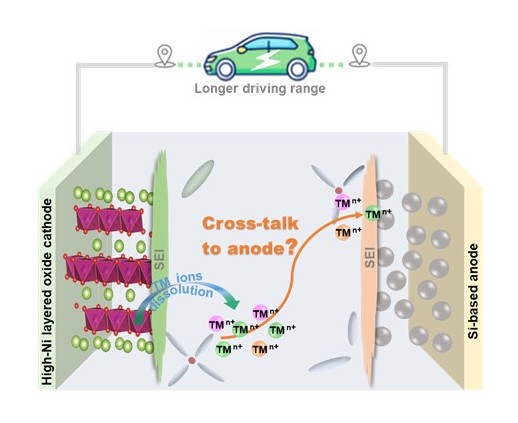Extreme Voltage
 The ever-growing demand for longer user time for portable electronics for soliders and consumers as well as longer driving distance for electric vehicles (EV) has prompted the development of lithium-ion batteries with higher energy density and longer life cycle. In this regard, increasing the nickel content in layered oxide cathodes above 80% and replacing the graphite anode with a composite anode consisting of graphite and silicon have become appealing as they offer higher capacities. However, both the high-nickel cathodes and graphite-silicon composite anodes suffer from rapid capacity fade. The objective of this project is to develop a fundamental understanding of the factors that limit the cycle life and devise approaches to overcome them. In this regard, the dissolution of transition-metal ions from the cathode and their migration to and deposition on the anode have been considered an impediment. Accordingly, this project focuses on (i) synthesizing high-nickel cathodes with nickel contents of 90% or above with optimal particle size and morphology and (ii) assessing the impact of different dissolved transition-metal ions on the performance of graphite-silicon anode in fuel cells fabricated with high-nickel cathodes and graphite-silicon anodes. The insights obtained will be utilized to enhance the life cycle while maintaining a high energy density.
The ever-growing demand for longer user time for portable electronics for soliders and consumers as well as longer driving distance for electric vehicles (EV) has prompted the development of lithium-ion batteries with higher energy density and longer life cycle. In this regard, increasing the nickel content in layered oxide cathodes above 80% and replacing the graphite anode with a composite anode consisting of graphite and silicon have become appealing as they offer higher capacities. However, both the high-nickel cathodes and graphite-silicon composite anodes suffer from rapid capacity fade. The objective of this project is to develop a fundamental understanding of the factors that limit the cycle life and devise approaches to overcome them. In this regard, the dissolution of transition-metal ions from the cathode and their migration to and deposition on the anode have been considered an impediment. Accordingly, this project focuses on (i) synthesizing high-nickel cathodes with nickel contents of 90% or above with optimal particle size and morphology and (ii) assessing the impact of different dissolved transition-metal ions on the performance of graphite-silicon anode in fuel cells fabricated with high-nickel cathodes and graphite-silicon anodes. The insights obtained will be utilized to enhance the life cycle while maintaining a high energy density.
PI: Arumugam (Ram) Manthiram, University of Texas at Austin
Top